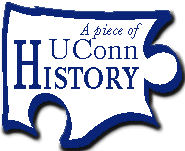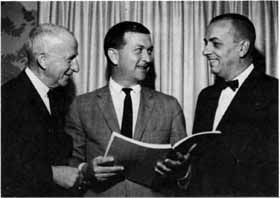|
This is an archived article.
For the latest news, go to the Advance
Homepage
For more archives, go to the Advance Archive/Search Page. |
||||||
|
Health Center's Birth Resulted
From Years of 'Careful Study' The Board of Trustees meeting for January 15, 1946, appears to be routine, judging from the minutes on file in the University Archives. But one agenda item was to prove far from routine — and would take nearly three decades to complete.
Board members that day voted on resignations and appointments of faculty and staff, approved the retirement of long-time faculty member Howard Seckerson, professor of English, and a pay raise for J.O. Christian, associate professor of physical education and football coach. They also asked President Albert Jorgensen to write an appropriate letter to G. Safford Torrey, professor of botany, on completion of 30 years of service. Then, toward the end of the meeting - held in Hartford, as most board meetings were at that time - Jorgensen discussed a letter he had received from Gov. Raymond Baldwin, dated Dec. 6, 1945. It was the prelude to what would become the UConn Health Center. Trustees voted "to make a careful study of the entire situation," and a committee of three was appointed. The study group included two new board members, Creighton Barker, a New Haven physician, and Edward A. Suisman of West Hartford, along with J. Raymond Ryan, an alumni trustee elected in 1944. Barker was named chair. It was a year before the three reported back - and theirs was just the first of more than a half-dozen studies by the State. Less than two months into the committee's work, trustees learned that Jorgensen had received a letter from Gov. Baldwin "regarding the interest of the Connecticut Dental Association in the establishment of a Dental School as part of the University." They referred the matter to the Creighton committee. The report was accepted by the board at its meeting on Jan. 15, 1947, and placed on file with the minutes. Basic to the report, said committee members, was the definition of 'need'. "If need is defined as a necessity for medical education to prepare additional physicians for public service in Connecticut, the answer is in the negative," the committee reported. "At no time in recent years or in the foreseeable future will Connecticut be under-supplied with physicians. "If need is defined as a necessity for better opportunities for qualified Connecticut youth to obtain medical education at a reasonable financial outlay, then the answer to the question is 'Yes'... "The Committee does not undertake precisely to define the need, but finds it difficult to forsake a proposal that would broaden the usefulness of the University by making medical education available to the state's sons and daughters." The committee did not spend much time on the question of a dental school, "in the belief that the establishment of a dental school separate from a medical school would be ill-advised." Creighton, who served on the board until 1950, discussed the report at the next board meeting, but there was no further action or discussion for several years. This was the era of rapid expansion for the University, with enrollment bulging as veterans flocked to get a college education and construction of new classrooms and dormitories topping the priorities of the University. With no pressing need for the new schools, the matter would wait for a later time. But although the University did not proceed, the State did, ordering more studies, based on reports from the medical community. In July 1953, for example, a Commission to Study Establishment of Medical, Dental and Veterinary Colleges on a New England Regional Basis was appointed by Gov. John Lodge, following a report from the New England Board of Higher Education calling for a regional approach. The commission reported in November 1954. It concluded that in the fields of medicine and dentistry, "additional educational facilities are urgently needed," that a regional approach "would seem to be the best way to accomplish this objective," and that the "most practical method of putting a New England Regional Compact together would be for Connecticut to build its own Medical-Dent al School, to be operated as part of the University of Connecticut, in the City of Hartford." After the commission held a hearing in Hartford, University Provost Albert Waugh wrote to the members of the legislature's education committee, telling them that the $6 million price tag for the project was "pretty close to the mark." He cited the University of Buffalo, which in 1954 paid $3.5 million for construction and $1 million to buy equipment medical and dental schools. Also in his April 15, 1955 letter, Waugh explained that the money would not all be needed at once. "The University could not use $6 million on this project during the coming biennium, even if the funds were available." Waugh continued, "experience shows that after the legislature approves the general project, it will take roughly two years to acquire a site and to procure the plans for specifications. "Consequently, if your committee wishes to approve the general project at this session, it would be necessary to make available for the current biennium only such funds as would be necessary to secure a site and to get plans and specifications." Waugh also kept notes on the hearing, and summarized them for Jorgensen. He noted that when asked by Mansfield's state representative , E.O. Smith, about the regional concept advanced by NEBHE, he replied: "The committee and General Assembly would have to decide on the need for medical and dental facilities, and, if (so), ... how the need could best be met. The University would gladly cooperate, whether the state decided to meet the need through the Compact or without one." Waugh told Smith, however, that as an individual, he would prefer to operate without a compact than with one. "I felt there would be more flexibility and less red tape," he said. "I felt, also, that there would be lower cost." Waugh also cautioned that there would be at least two years for construction, and that graduating the first classes of doctors and dentists would come four years after that - followed by a year of residency. Ultimately, he said, what they were discussing in 1955 was something that would not bear fruit until 1964 at the earliest. The General Assembly in June 1955 instructed UConn's trustees and the State Board of Education to study the matter further; the December 1956 report from the two boards included a recommendation that the schools be developed. A month later, the General Assembly gave its approval for medical and dental schools, independent of the NEBHE plan. In October 1960, the Kellogg Foundation awarded a $1,037,500 grant to the University to help develop and construct facilities for a two-year school of basic medicine. And the General Assembly in 1961 authorized an appropriation of $2 million toward the construction of a two-year medical-dental school, with a nine-member commission to select a suitable site. The University announced in May 1962 a $1 million grant from the NIH to help finance the new medical and dental facilities. A month later, the site commission announced selection of a 107-acre tract in Farmington, and the University then announced formation of a 10-member committee of leading hospital administrators and medical and dental educators from Connecticut as a Professional Advisory Committee. In the first of many semi-annual progress reports to the legislature, UConn trustees noted in mid-1963 that a "total of eight studies were commissioned on this subject during the two decades preceding the first legislative commitment of funds in 1961. Shortly after the legislature committed $7 million more for the project in May 1963, UConn's new president, Homer D. Babbidge, announced that Lyman Stowe, associate dean of Stanford University's School of Medicine, would be the first dean of the new medical school, and that Lewis Fox, a leading periodonist and dental educator, had been named dean of the dental school. Stowe was also to coordinate planning for what was now being called the University of Connecticut Health Center.
Two months later, on July 8, the state took title to the site in Farmington. John Patterson, appointed dean of medicine after Lyman Stowe's death on June 2, 1965, reported in 1966 that the Health Center library had been established and staffed in 1965-66 and his target for the first classes was fall 1968, with 48 medical and 48 dental students. By now, cost estimates had risen to the $50 million range. Construction began in July 1967, but Patterson reported that delays would require smaller starting classes. With 59 staff and 10 department heads hired, 30 medical and 18 dental students began taking classes in the fall of 1968. A clinical program at McCook Hospital, a former municipal hospital now run by UConn, had begun on July 1, 1967. Patterson reported in August 1969 that the past year marked "the beginning of the operational phase of the new University of Connecticut Health Center." In May 1972, just one month after construction of the first phase of the project - the academic and research facilities - was completed, the University graduated its first class of physicians and dentists. Phase two, the John Dempsey Hospital, was completed and dedicated in 1975 - nearly 30 years after the Trustees had voted to make a careful study. Mark J. Roy |



